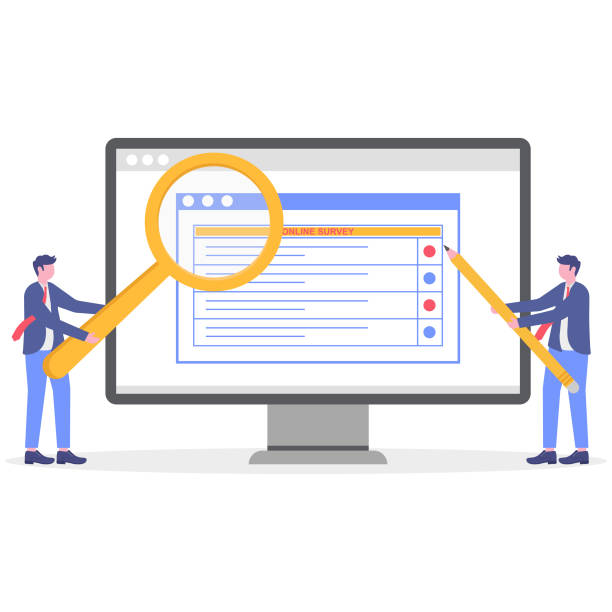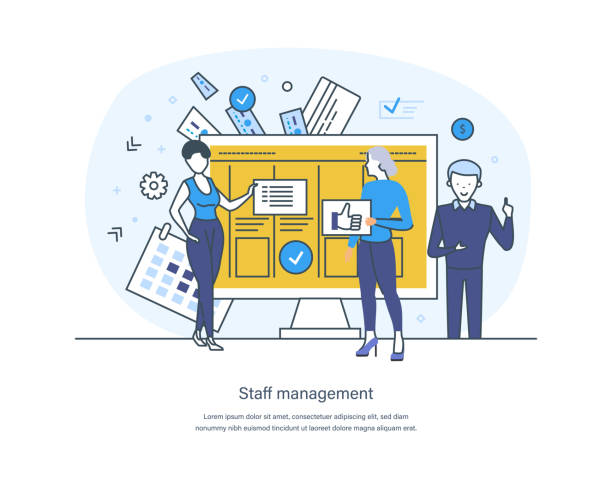Introduction to Secure Website Design Principles

In today’s digital world, where valuable information flows across the web, #Web_Security is no longer an option, but an undeniable necessity.
#Data_Protection and #Website_Design must be at the core from the very beginning of the development process.
This is a proactive approach that protects your website against cyber threats and earns user trust.
When we talk about secure website design, we don’t just mean installing an SSL certificate, but creating a complete and comprehensive ecosystem that includes all security layers, from server infrastructure to application coding and even user training.
This explanatory and educational approach helps you to become familiar with the fundamental principles of web security and understand its importance.
The ultimate goal of secure website design is to ensure the confidentiality, integrity, and availability of data, so that sensitive user information is protected against unauthorized access and malicious attacks.
Insecure websites can become easy targets for hackers and cause irreparable damage.
Therefore, investing in secure website design is, in fact, an investment in the future and credibility of your business.
Does your current website convert visitors into customers or drive them away? Solve this problem forever with professional corporate website design by Rasawp!
✅ Build credibility and powerful branding
✅ Attract target customers and increase sales
⚡ Get a free consultation now!
Why is Secure Website Design Crucially Important?

In the information age, #User_Trust is the most important asset of any online business, and #Security_Vulnerabilities can quickly erode this trust.
Every year, numerous news reports are published about data breaches and widespread cyber attacks, leading to astronomical #Attack_Costs and irreparable damage to companies’ reputations.
From an analytical and news perspective, neglecting secure website design can lead to serious legal consequences, including heavy fines for data privacy violations.
For example, in Europe, the General Data Protection Regulation (GDPR) obliges companies to adhere to the highest security standards, and non-compliance results in heavy penalties.
Furthermore, cyber attacks such as Distributed Denial of Service (DDoS) attacks can take a website offline, leading to loss of customers and revenue.
Imagine an e-commerce website going offline for just a few hours; this can result in significant financial losses.
Therefore, secure website design is not merely a technical requirement, but a strategic investment for maintaining the stability and growth of your business.
Website security must be considered an integral part of the overall business strategy, as without it, all efforts to attract customers and provide quality services may be lost in an instant.
Common Vulnerabilities and Countermeasures

Understanding common #Security_Vulnerabilities is the first step towards secure website design.
The OWASP (Open Web Application Security Project) organization publishes a list of the top 10 vulnerabilities, which serves as an expert guide for developers and security professionals.
Among these vulnerabilities is #SQL_Injection, which allows attackers to gain access to the database by injecting malicious SQL code.
Another is #XSS (Cross-Site Scripting), which enables attackers to execute malicious scripts in users’ browsers.
Also, #CSRF (Cross-Site Request Forgery) allows attackers to perform unwanted actions on behalf of authenticated users.
To counter SQL Injection, parameterization and prepared statements should be used.
For XSS, all user inputs must be filtered, and outputs must be encoded.
To prevent CSRF, the use of CSRF tokens in forms is essential.
These vulnerabilities are just examples of the countless threats that target an insecure website.
To ensure website security, one must not only be familiar with these threats but also continuously keep systems updated and adhere to best software development practices.
The guidelines provided by OWASP are an excellent resource for a deeper understanding of these vulnerabilities and for implementing appropriate defensive mechanisms.
Secure website design requires a comprehensive approach that includes code review, server configuration, and continuous training for the development team.
The ultimate goal is to build a robust barrier against all known and emerging attacks so that sensitive user information and your business’s reputation are always safe.
| Vulnerability Name | Brief Description | Countermeasure |
|---|---|---|
| SQL Injection | Injecting malicious SQL code into the database for unauthorized access. | Using Prepared Statements and input validation. |
| Cross-Site Scripting (XSS) | Injecting malicious scripts into web pages that are executed in users’ browsers. | Filtering and encoding all user inputs and outputs. |
| Broken Authentication | Flaws in authentication and session management implementation that allow attackers to impersonate users. | Implementing strong authentication mechanisms, Multi-Factor Authentication (MFA). |
| Insecure Deserialization | Insecure deserialization of data that allows an attacker to execute code remotely. | Continuous monitoring and validation of the deserialization process, avoiding deserialization of untrusted data. |
Best Practices in Secure Coding

The core of secure website design is #Secure_Coding.
Developers must adhere to security principles from the outset, throughout all stages of software development.
One of the most important principles is #Input_Validation.
Any data entered by the user into the system, regardless of its source, must be carefully validated and filtered.
This includes checking the data type, length, format, and content to prevent injection of malicious code or data.
#Session_Management is also of high importance; sessions must have a defined lifespan, expire after inactivity, and session tokens must be securely generated and stored.
Additionally, proper error handling and event logging play a significant role in website security.
Generic error messages should be displayed to users to prevent disclosure of sensitive system information, and detailed error information should be stored in security logs to allow tracking and investigation of attacks.
Using secure and up-to-date APIs, instead of old and vulnerable libraries, is also crucial.
This educational and specialized section emphasizes that a coder must always be up-to-date and aware of new vulnerabilities.
User input data should never be trusted and should always be examined with the assumption of being malicious.
This proactive approach forms the backbone of secure website design and prevents many common attacks.
Is your online sales not as expected? With Rasawp, solve the problem of low sales and poor user experience forever!
✅ Increase visitor-to-customer conversion rate
✅ Create an enjoyable user experience and increase customer trust
⚡ Act now to get a free consultation!
Ensuring Server and Infrastructure Security

Secure website design is not limited to coding; ensuring #Server_Security and infrastructure is equally vital.
Servers must be regularly updated, and all #Security_Patches must be applied.
Any unnecessary software or additional services should be removed from the server to reduce the attack surface.
#Server_Configuration must be done carefully, including settings related to access, permissions, and resource limitations.
Using a strong firewall, whether software or hardware, is essential for controlling incoming and outgoing server traffic and blocking unauthorized access.
Furthermore, server access must be restricted and granted only to authorized individuals.
Using SSH Key Pair instead of passwords for remote access is recommended.
Also, continuous monitoring of server logs to identify suspicious activities and potential attacks is a specialized step and an important guide in website security.
These measures provide strong defensive layers at the infrastructure level, complementing application-level security.
A secure website design requires a multi-layered approach where every part of the system, from code to hardware, is configured and maintained with the highest security standards.
This is especially critical for websites that process a large volume of sensitive data.
Practical Authentication and Authorization

Within the framework of secure website design, authentication and authorization systems are critical points for protecting user information.
Implementing #Two_Factor_Authentication (2FA) or Multi-Factor Authentication (MFA) is essential to enhance the security of user accounts.
This method provides an additional layer of security, even if the password is compromised.
#Password_Management should include strong password policies that require users to use complex and unique passwords.
Passwords must be stored as hashes using strong algorithms like bcrypt.
#Access_Control based on roles (Role-Based Access Control – RBAC) is also a key principle in authorization.
This system ensures that each user only has access to the resources and functionalities required for their tasks.
This is an explanatory and educational approach that helps prevent unauthorized access and reduce the attack surface.
Website security in this section means that every user request is carefully examined to ensure the user has the necessary permissions to perform that action.
Proper session management is also highly important; sessions must have an expiration time and be destroyed quickly after the user logs out.
Adhering to these principles in secure website design prevents many authentication and authorization-related attacks and provides a solid layer of defense against unauthorized access.
Encryption and Data Privacy

One of the main pillars of secure website design is #Data_Encryption and preserving #Privacy of user information.
Using HTTPS, which employs an #SSL/TLS certificate, is essential for encrypting communications between the user’s browser and the server.
This ensures that data is protected from eavesdropping and tampering during transit.
In addition to encrypting data in transit, encrypting data at rest in databases or on servers is also crucial, especially for sensitive information such as financial or personal data.
International standards such as GDPR (General Data Protection Regulation) in Europe and CCPA (California Consumer Privacy Act) in California require companies to adhere to the highest level of data privacy and security.
These regulations provide specialized guidance for managing personal data, and non-compliance can result in very heavy fines.
Website security in this context means implementing strong privacy policies, transparency in data collection and use, and granting users the right to control their personal information.
Secure website design must include regular review and updating of encryption protocols to remain resilient against decryption attacks.
| Encryption Method | Brief Description | Primary Use |
|---|---|---|
| HTTPS/TLS | Encrypting data during transit between browser and server using digital certificates. | Ensuring web communication security (confidentiality and integrity). |
| AES (Advanced Encryption Standard) | A symmetric encryption algorithm with a shared key for encryption and decryption. | Encrypting data at rest and in transit. |
| RSA (Rivest–Shamir–Adleman) | An asymmetric encryption algorithm with a public and private key pair. | Secure key exchange, digital signatures, and encryption of small data. |
| Hashing (e.g., SHA-256, bcrypt) | Converting data into a unique and irreversible hash value. | Secure password storage, data integrity checking. |
Security Audits and Regular Updates

Even after secure website design, the work of ensuring security never ends.
#Security_Audits, #Penetration_Testing, and #Vulnerability_Scanning are crucial components for maintaining website security in the long term.
These activities help identify new weaknesses and vulnerabilities before they are discovered and exploited by attackers.
#Software_Updates for all used libraries and frameworks are also of high importance, as attackers are constantly looking for security gaps in older versions.
From an analytical and news perspective, large companies also fall victim to cyber attacks, often due to a lack of regular updates or insufficient security audits.
This indicates that website security is a continuous process, not a one-time project.
Periodic penetration testing by external security specialists can provide valuable insights into system weaknesses that might have been overlooked by internal developers.
Additionally, using automated vulnerability scanning tools can continuously monitor the website for common security issues.
These measures allow you to actively respond to new threats and ensure the stability and security of your website.
Secure website design is an ongoing commitment that requires continuous vigilance and proactive measures.
Does your current website convert visitors into customers or drive them away? Solve this problem forever with professional corporate website design by Rasawp!
✅ Build credibility and powerful branding
✅ Attract target customers and increase sales
⚡ Get a free consultation now!
Incident Response and Disaster Recovery

Even with the best secure website design, the possibility of a security incident is never zero.
Therefore, having an #Incident_Response_Plan and a #Disaster_Recovery strategy is vitally important.
This plan should include specific steps for identification, containment, eradication, recovery, and post-incident analysis.
The security team must be adequately trained, and responsibilities must be clearly defined to minimize chaos during a crisis.
#Data_Backup is the cornerstone of disaster recovery.
Backup copies must be encrypted and stored in separate, secure locations, and they must be capable of fast and complete recovery.
This is an explanatory guide to ensuring business continuity in the event of a cyber attack, hardware failure, or natural disaster.
Website security means being prepared for the worst-case scenarios.
Regularly practicing incident response and disaster recovery plans helps the team operate efficiently in real-time.
The ultimate goal is to minimize downtime and data loss so that the website can quickly return to normal operation and user trust is maintained.
Secure website design is not just about preventing attacks, but also about how to effectively respond to them and quickly restore services.
The Future of Secure Website Design and New Challenges

The future of secure website design is accompanied by new challenges and opportunities emerging due to technological advancements.
The use of #AI_Security and machine learning can help identify more complex attack patterns and automate responses, but it also introduces new security challenges.
The role of #Blockchain in increasing data transparency and security, especially in authentication systems and sensitive data storage, is a contentious topic and currently under investigation.
Also, with the expansion of the Internet of Things (IoT), #IoT_Security has become a major concern that can open new gateways for cyber attacks on websites.
How will secure website design address these challenges in the future? This is an intriguing and yet serious question that requires continuous research and innovation.
Developers and security professionals must adapt to these new technologies and provide innovative security solutions to counter evolving threats.
From post-quantum cryptography to decentralized identities, the future of website security looks complex and exciting.
This requires extensive collaboration among the cybersecurity community, developers, and researchers to ensure that the web remains a secure space for users and businesses.
Secure website design in this landscape will evolve beyond code and servers into an intelligent and dynamic ecosystem to combat the threats of tomorrow.
Frequently Asked Questions
| # | Question | Answer |
|---|---|---|
| 1 | What is secure website design? | Secure website design is a process in which websites are built with security measures in mind from the early stages of development to protect against cyber attacks, unauthorized access, and data loss. |
| 2 | Why is secure website design important? | Website security is crucial for maintaining user trust, protecting sensitive information (personal and financial), preventing damage to brand reputation, and complying with privacy and security regulations (such as GDPR). A security breach can lead to financial and legal damages. |
| 3 | What are the most common cyber attacks a website faces? | Some of the most common attacks include SQL Injection, Cross-Site Scripting (XSS), Distributed Denial of Service (DDoS), Brute Force, and credential-based attacks (Credential Stuffing). |
| 4 | What is SQL Injection and how can we prevent it? | SQL Injection is a type of attack where an attacker attempts to manipulate the database or extract information by injecting malicious SQL code into site inputs. To prevent it, one should use Prepared Statements/Parameterized Queries, ORM (Object-Relational Mapping), and strict input validation. |
| 5 | What is Cross-Site Scripting (XSS)? | XSS is a type of attack where an attacker injects malicious scripts (usually JavaScript) into web pages that are executed by other users’ browsers. This can lead to the theft of cookies, session information, or alteration of the website’s appearance. |
| 6 | How can Brute Force attacks on login pages be prevented? | To prevent Brute Force attacks, one should use CAPTCHA, limit the number of failed login attempts (Account Lockout), implement two-factor authentication (2FA), and use complex and long passwords. |
| 7 | What is the role of HTTPS in website security? | HTTPS encrypts communication between the user’s browser and the website server using SSL/TLS. This prevents eavesdropping, tampering, or forgery of information during transmission and increases user trust. |
| 8 | What is the importance of Input Validation in security? | Input validation is the process of checking and sanitizing data entered by the user. This prevents the injection of malicious code, XSS attacks, SQL Injection, and other vulnerabilities, and ensures that the data conforms to the expected format. |
| 9 | Why are regular updates of website systems and software essential? | Regularly updating the operating system, CMS (like WordPress), plugins, themes, and libraries used addresses known security vulnerabilities. Hackers often exploit weaknesses in outdated software to infiltrate. |
| 10 | What role does regular backup play in secure website design? | Regular and tested backups of website data (database and files) are a critical layer of defense against data loss due to cyber attacks, human errors, or hardware failures. This allows for quick website recovery in the event of a disaster. |
And other advertising agency services by Rasawp in the field of advertising
Smart Sales Automation: A combination of creativity and technology to improve SEO ranking through SEO-centric content strategy.
Smart Advertorial: A dedicated service for growing user engagement based on real data.
Smart UI/UX: Professional optimization for digital branding using key page optimization.
Smart Sales Automation: An innovative platform for improving customer behavior analysis with attractive UI design.
Smart Brand Identity: A fast and efficient solution for customer acquisition, focusing on custom programming.
And over hundreds of other services in the field of internet advertising, advertising consulting, and organizational solutions
Internet Advertising | Advertising Strategy | Advertorials
Sources
What is Website Security and How to Ensure It?
Website Security: From Zero to One Hundred!
Comprehensive Guide to Website Security
The Importance and Necessity of Website Security
? Are you ready to grow your business in the digital world? Rasawp Afarin, a leading digital marketing agency, will be your guide on the path to success by offering comprehensive services including fast website design, SEO, and content marketing strategies. With us, have a powerful presence on the web.
📍 Tehran, Mirdamad Street, next to Bank Markazi, Southern Kazeroun Alley, Ramin Alley, No. 6



